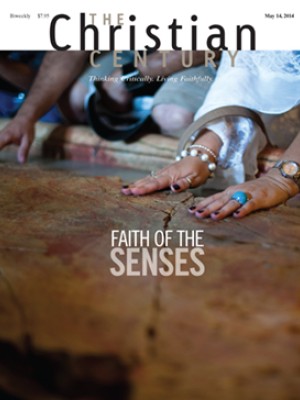Debates linger after tests on ‘Jesus’ wife’ papyrus
A year and a half after unveiling a slip of papyrus that she dubbed “The Gospel of Jesus’s Wife,” Harvard biblical scholar Karen King has released the results of long-delayed testing on the controversial fragment which appear to show that it is not a modern forgery.
Questions remain, however, with some experts still wondering whether it is a fake and others doubting the value of the tests.
King said she feels vindicated because the tests show that the fragment, which is about the size of a business card, and the writing on it are ancient and therefore authentic.
“I’m hoping now that we can turn away from the question of forgery and talk much, much more about the historical significance of the fragment and precisely how it fits into the history of Christianity and questions about family and marriage and sexuality and Jesus,” King told reporters on April 10.
Read our latest issue or browse back issues.
Possible theological implications stirred controversy after King presented the fragment at a conference in Rome in September 2012 and continued to do so in the wake of this latest announcement.
“Nearly every scholar believes that Jesus was unmarried. So do I,” said James Martin, a Jesuit priest and author of a new book on Jesus. “My faith,” Martin added, “does not rest on his being unmarried—but my reason tells me that he was.”
For example, Martin said, it would be odd for accounts of his life not to mention a wife if he had one, and the newly discovered papyrus was written well after the canonical Gospels.
The fragment, written in Coptic, consists of just eight lines and 33 words of an interrupted conversation, likely snipped from a larger papyrus.
At two points Jesus speaks of his mother, his wife, and a female disciple, one of whom may be identified as “Mary.” When the disciples discuss whether Mary is worthy, Jesus states that “she can be my disciple.”
A similar rivalry between a Mary and other disciples, especially Peter, is reflected in at least two other apocryphal gospels, the Gospel of Thomas and the Gospel of Mary, with the latter text favoring the woman follower.
King has stressed that the recently tested fragment does not indicate that Jesus was married, and she says the text is not in fact focused on that issue.
“The main topic of the fragment is to affirm that women who are mothers and wives can be disciples of Jesus—a topic that was hotly debated in early Christianity as celibate virginity increasingly became highly valued,” explained King, an authority on apocryphal writings.
Not everyone was satisfied with the latest findings on the papyrus.
“The papyrus fragment seems ripe for a Monty Python sketch,” Leo Depuydt, an Egyptologist at Brown University, wrote in a blistering rebuttal to King. His analysis appears in the new edition of the Harvard Theological Review. Depuydt also maintains that the Coptic language used in the papyrus contains “a couple of fatal grammatical blunders” that render it “patently fake.”
Critics point to other issues:
• The testing indicates that the papyrus could be as recent as 859, which is 400 years later than King first thought and much later than the accounts from the New Testament.
• Tests on the composition of the ink showed that it was of a type used between 400 BC and as late as AD 800, a very wide window.
• While the ink appears to be of a type and pattern used by ancient writers, the ink itself could not be tested without destroying the papyrus.
• The language Jesus uses about a wife could be metaphorical and may indicate he was referring to the church as his bride, not a real woman.
Speaking to reporters, King acknowledged those criticisms but said they did not affect the validity or import of the fragment. She said the later dating did not matter too much because she has always believed the writing was copied from a much earlier document, probably from the second or third century. She said an analysis of the writing showed it falls in the range of the papyrus itself, and she said there are other examples of similar grammatical errors in other ancient writings.
“There’s a limited amount of takeaway you can do from something that small,” she said.
King also acknowledged that the uncertain sourcing of the document was unfortunate but could not be helped. The anonymous owner of the fragment told her only that he bought it and five other papyri in 1999 from a collector who said he acquired them in what was then communist East Germany in 1963.
King said that Harvard Divinity School has the papyrus and that over the weekend the owner—who will not reveal his identity—wrote her an e-mail proposing that it remain there on permanent loan. Harvard is considering the idea, she said.
King said she was still surprised at the public fascination with the topic. Her original research article on the fragment was put on hold, as was a Smithsonian Channel documentary, which will now air with updated information.
“My intent from the beginning was to do this in a responsible way,” King said. But, she continued, “I’m not sure it [the controversy] could have been avoided, actually.” —RNS/added sources
This article was edited April 29, 2014.






